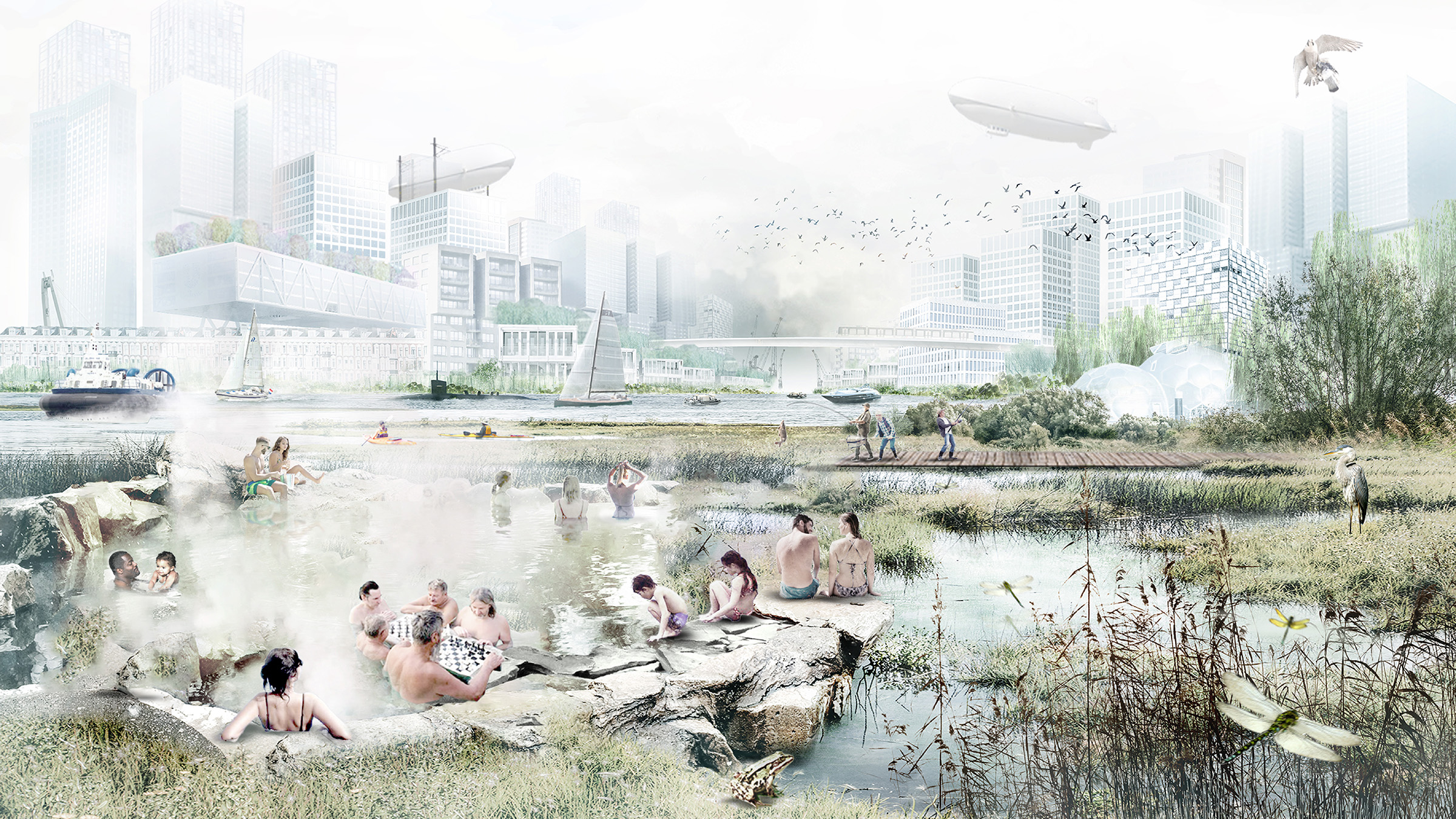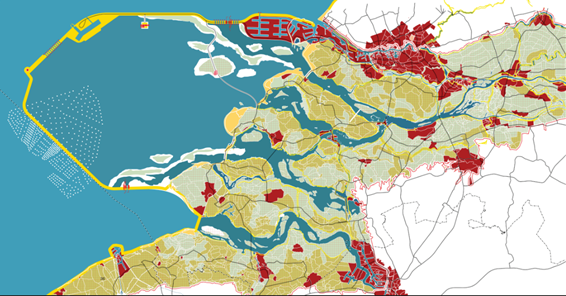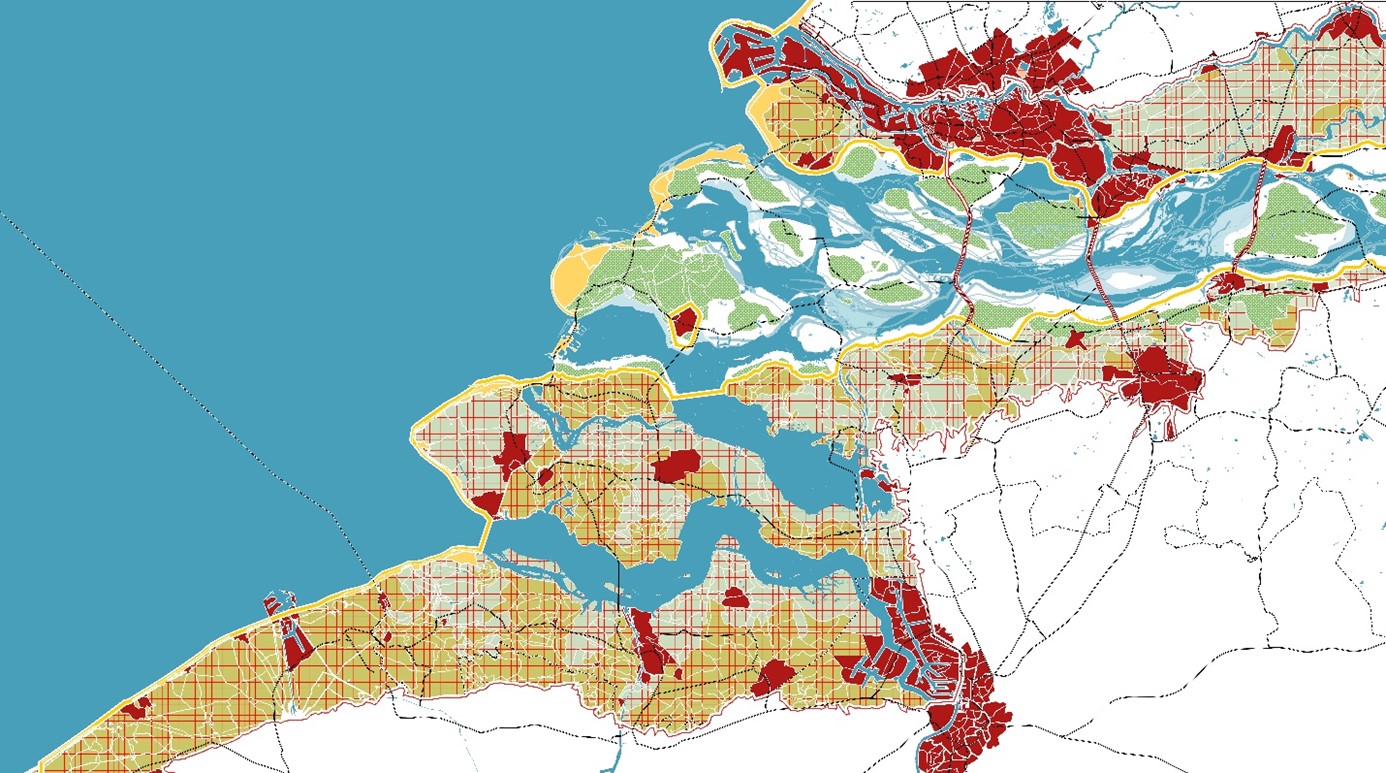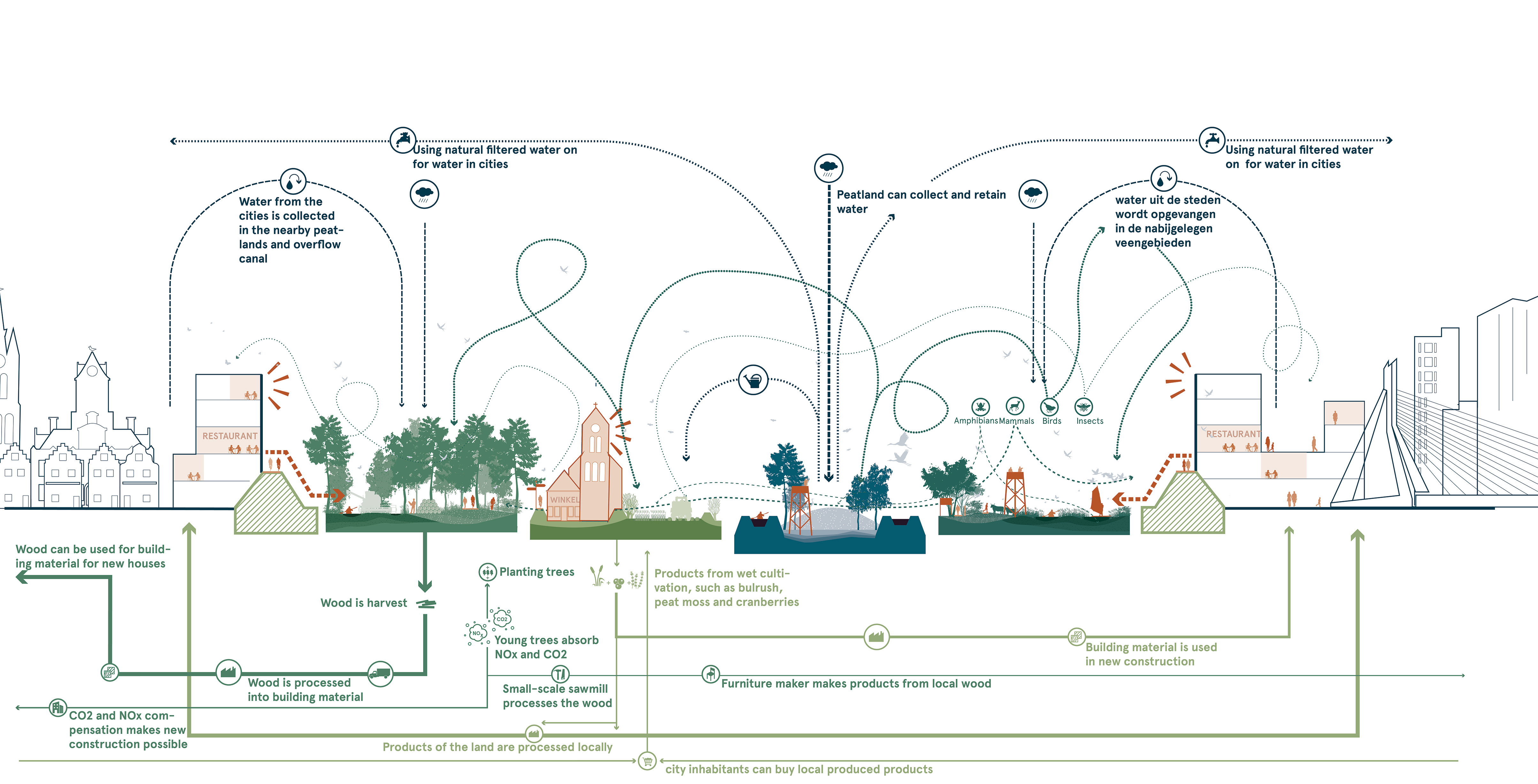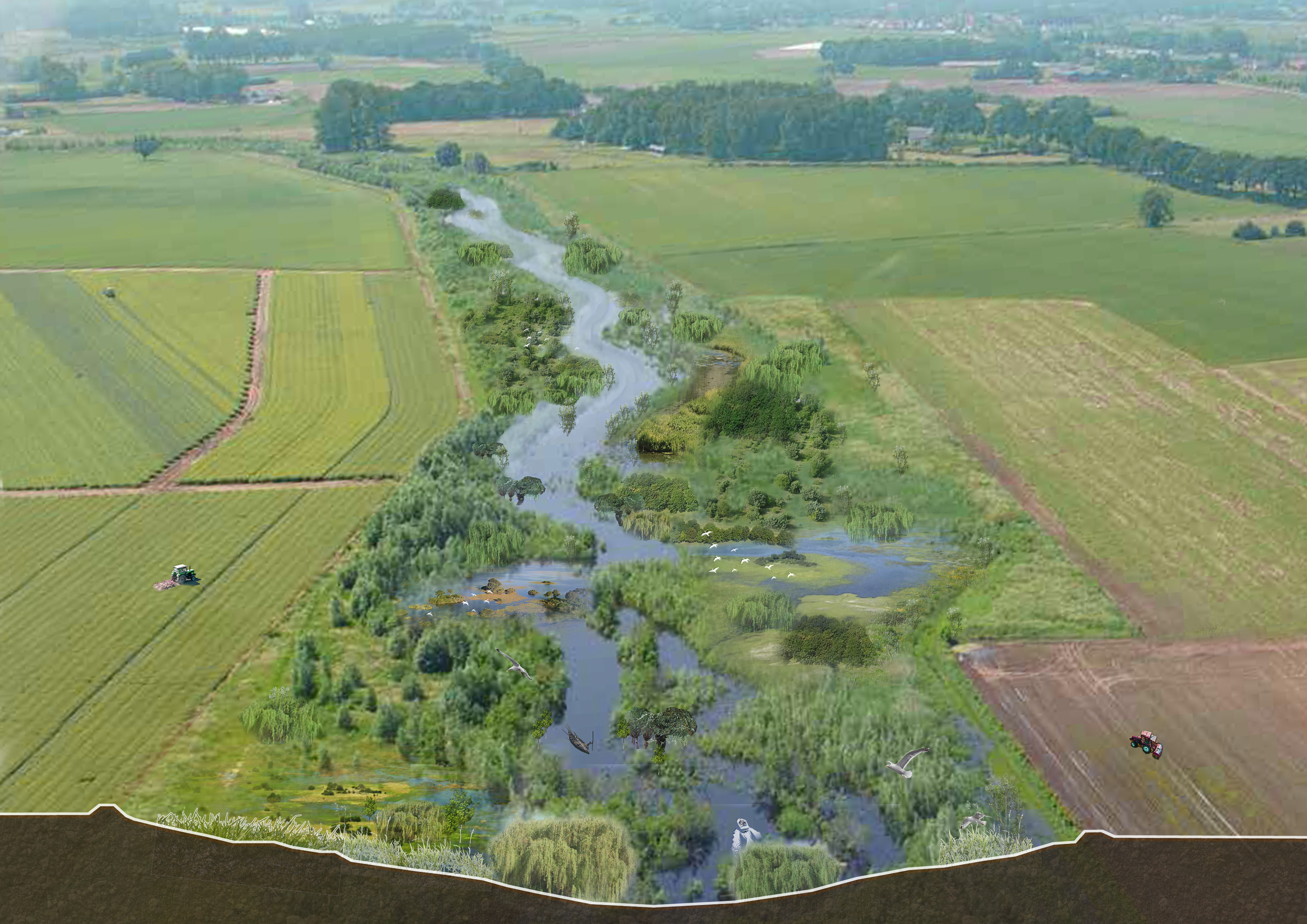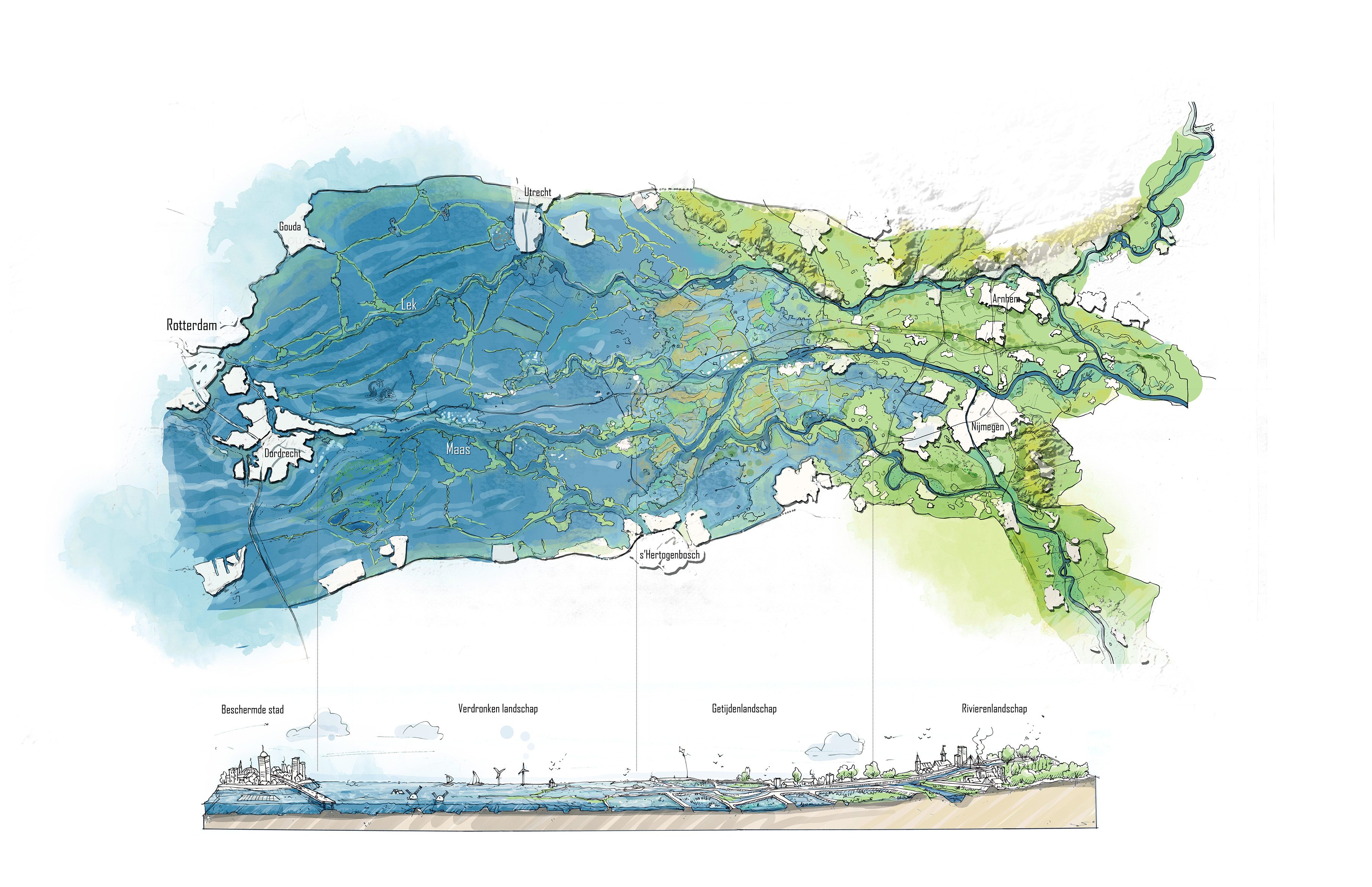Five future strategies for the Dutch delta in 2120
A design approach is needed to keep the Dutch delta safe and liveable in the future. Researchers, urban planners, landscape architects and engineers created innovative designs for 5 regions in the Netherlands as part of the Redesigning Deltas movement. Their approach and the designs should spur bold long-term planning for our delta. The proposals were unveiled at the International Architecture Biennale now taking place in Rotterdam and can also be reviewed online.
Should we give rivers and the sea free rein and retreat into densified metropolises? Can we give nature the freedom to buffer in times of abundance and scarcity? Are we going to ask companies to raise their land? Ask people to live differently?
It's time to think about such drastic interventions, a group of researchers believes. They have united in the Redesigning Deltas movement: TU Delft, Deltares, Erasmus University Rotterdam, the convergence alliance Resilient Delta, Wageningen University, PBL and IHE are working together with practitioners to make it happen. As the effects of climate change are occurring more often and faster than previously thought, we need to act now to make sure we have major spatial interventions prepared in time. The Redesigning Deltas design study has produced a manifesto, illustrated in these five designs, and shows how making designs helps to accelerate thinking about the future of our delta. Experiences, insights and results will be shared with the Delta Program.
Have a look at the designs:
- Zeelandia
- Rotterdam as sponge city
- Midden-Delfland as National Productive National Park
- Limburg: in the capillaries of the Delta
Climate extremes
"To keep the Netherlands liveable, accessible and safe, we must dare to look far ahead and thus anticipate a rise in sea level, an ever-declining soil, salinization and other climate extremes," states Ellen Tromp (Program Manager at Deltares and co-initiator of the program). "The long-term adaptation task already requires a different way of designing, as all expertise must be combined. The combination of design research and physical system analysis offers opportunities."
Research by design
The Redesigning Deltas movement is harnessing the power of design to look at and change reality in a different way. "Designing is inventing,” says Fransje Hooimeijer (associate professor of Delta Urbanism at TU Delft and co-initiator). "It forces you to bring together the different insights of your team. In this way, design helps to come up with the necessary integral strategy for the (re)design of our country."
In five teams, urban planners, landscape architects and engineers from 15 offices worked together on five "moments" in the Delta: Zeeland, Limburg, the city and port of Rotterdam, polders in Midden-Delfland and the river area of the Waal River. The teams were tasked with creating a design that takes into account 2 to 3 meters of sea level rise. The visions considered housing, freshwater supplies, energy generation, infrastructural adaptations, ecological and economic consequences.
That yields designs that can be quite provocative. "A provocative proposal takes people outside their comfort zone," Hooimeijer said. "That forces you to think differently about your own discipline. Extreme designs are sometimes necessary to achieve realistic solutions."
The five visions also reveal where the bottlenecks are that stand in the way of a solution and irrevocably raise questions. With these research questions, the Redesigning Deltas consortium is moving forward in designing a five-year research program.
The five cases
1. Zeelandia
Review the design on the website.
Studio Hartzema, Feddes-Olthof and Witteveen & Bos
Zeelandia proposes a new symbiosis between land and sea. Housing, nature, ecology, agriculture, aquaculture, energy and other forms of land use find space in the powerful landscape of the Southwest Delta. For this, the team sees the area as an ideal laboratory. Three different water scenarios were studied for a sea level rise of 3 meters and the consequences for spatial planning were calculated. Scenario Zeewaart creates a large fall lake off the coast of Zeeland that protects the land and also helps generate energy. A Superdelta scenario was also designed in which, on the contrary, space is given to the water and the sea can penetrate our country as far as the German border.
2. Rotterdam spongecity
Urbanisten, Lola, Royal Haskoning DHV
Review the ful design online
In this design, by expanding ring 14, Rotterdam becomes a sponge city with its own fresh water supply as the Meuse becomes a fresh inland lake. Collected rainwater can be buffered locally in the city. This allows the city to meet its own water needs. The port falls outside the ring road and will be raised in the future, entirely in the existing tradition, to keep the economic engine running permanently. Every thirty years a plot will be raised and redeveloped in balance with nature.
3. Midden-Delfland as Nationaal Productief National Park
Zus, Flux en Sweco
Review the full design online.
This team sees Delfland as a National Productive Park. Warmer summers will increase drought in surrounding cities, population growth makes surrounding cities denser and increases the need for surrounding nature, water and air. Midden-Delfland must become a green lung and a sponge for the livability of surrounding cities. This design assumes a simplified water system with fewer dikes, pumps and sluices, with opportunities for increasing biodiversity, providing raw materials such as wood and food and offering a solution to flooding, subsidence and the threat of salinization. The urban edges of Rotterdam and Delft will form a high urban framework for Midden-Delfland and stay within this boundary to protect the area as a green lung.
4. Limburg: in de capillaries of the Delta
Defacto, Vista and Arcadis
Review the full design online.
How can the gully valley in Limburg better retain water to prevent flooding during extreme precipitation events? This team's design aims to give space to water and includes many interventions to capture, slow down and drain water. This means restoring the entire landscape as a sponge with traditional grafts and forests. The design also highlights changes to the landscape needed to make it more productive, such as for storing CO2.
5. Maas-Waal corridor: Breakthrough!
Fabrications, BoschSlabbers, Tauw
Review the full design online.
The premise of the Waal River Corridor team is an extreme scenario. They argue that in the long run our water system with dikes and Delta Works will not work. Eventually, the inevitable system crash will occur: the river system will return to its natural flow in an open route between hinterland and sea. The only thing we can do is to guide this "crash," betting now on a semi-open system and managing this disaster-in-slow-motion. The design includes evacuation scenarios, retreat strategies and ways of rebuilding in which we re-learn to live with the seasons and the dynamics of the natural system, for example, on sandy islands in seasonal homes.
More information
The designs are on display at the International Architecture Biennale in Rotterdam through Nov. 13. More about the Redesiging Deltas program can be found on the website.
For questions, please contact Karlijn Spoor, communication advisor Resilient Cities & Mobility at TU Delft: 06-41612272 or k.spoor@tudelft.nl.
The program is an initiative of the Delta Urbanism group of TU Delft's Faculty of Architecture. Partners are the Convergence Alliance Resilient Delta (the partnership of TU Delft, Erasmus MC and Erasmus University), Deltares, Wageningen University & Research, PBL and IHE Delft. Experiences, insights and results will be shared with the Delta Program.
TU Delft | Resilient Cities & Mobility
Bij de TU Delft onderzoeken, ontwerpen en realiseren we de steden van de toekomst. Steden die op een duurzame manier gebouwd worden en veerkrachtig zijn zodat ze opgewassen zijn tegen grote, hedendaagse uitdagingen zoals klimaatverandering en bevolkingsgroei. Steden waar innovatie en economische groei mogelijk is, maar waar net zo goed oog is voor welzijn van de bewoners, voor gezondheid, inclusiviteit en gelijkheid. Hiernaast werken we aan de duurzame, slimme infrastructuur en mobiliteit van de toekomst, zodat we ons goed en efficiënt kunnen blijven verplaatsen zonder het milieu nog meer te belasten. We doen dit door middel van multidisciplinair onderzoek, en door samen te werken met verschillende partijen zoals bedrijven, overheid en burgers.
Zo werkt de TU Delft met Erasmus Universiteit en Erasmus MC samen in de Convergentie alliantie Resilient Delta. De missie van Resilient Delta is het ontwerpen van veerkrachtige oplossingen in de Rotterdamse delta voor implementatie wereldwijd. Ons doel is om een geïntegreerde aanpak te ontwikkelen voor de grote maatschappelijke vraagstukken waarmee de Rotterdamse regio in toenemende mate wordt geconfronteerd, zoals de stijgende zeespiegel, armoede en ongelijkheid, luchtvervuiling, bevolkingsdichtheid en grote technologische veranderingen.
